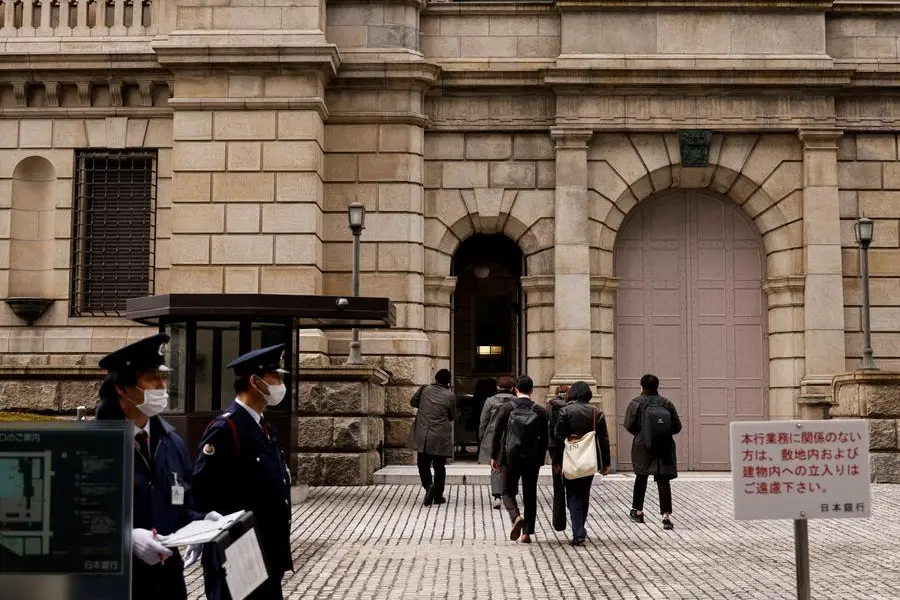PHOTO
TOKYO - The Bank of Japan is laying the groundwork to end negative interest rates by April and overhaul other parts of its ultra-loose monetary framework, sources say, but is likely to go slow on any subsequent policy tightening amid lingering risks.
The clearest hint of a change to date came from a summary of debate at the BOJ's January meeting released last week, where some policymakers called for an immediate policy shift including one who said now was a "golden opportunity" to phase out stimulus.
At the meeting, the BOJ kept ultra-low rates intact but said the likelihood for sustainably achieving its 2% inflation target was heightening, signalling a growing conviction that conditions for phasing out its massive stimulus were falling into place.
"If we get further evidence that a positive wage-inflation cycle will heighten, we'll examine the feasibility of continuing with the various steps we are taking under our massive stimulus programme," Governor Kazuo Ueda told a post-meeting briefing.
"We think we can avoid any big discontinuity" upon ending negative rates, he said, suggesting the BOJ will go slow in any subsequent rate hikes.
While Ueda did not pre-commit to a specific timing of an exit, the hawkish comments led many investors to bet on an end to negative rates either in March or April.
"Piecing together its communication so far, it's fair to say the BOJ has its eyes set on April as the preferred timing of an exit," a source familiar with its thinking.
"Markets have correctly received the BOJ's message," another source said on heightening expectations of a near-term end to negative rates.
Upon ending negative rates, the BOJ will abandon all or most of its bond yield control, but pledge to keep buying enough bonds to prevent an abrupt spike in yields, the sources say.
The BOJ may also discontinue its risky asset purchases, but hold off selling its holdings any time soon, they say.
"When negative rates end, other parts of the framework will come under review," a third source said. All the sources spoke on condition of anonymity due to the sensitivity of the matter.
DATA RISKS
Since taking the helm in April 2023, Governor Kazuo Ueda has moved toward dismantling his predecessor's radical stimulus beginning with a tweak to its controversial yield curve control (YCC) policy that caps long-term rates around 0%.
Discussions of an exit began to intensify in December when, for the first time, some in the nine-member board said the BOJ could afford to keep monetary conditions accommodative even after ending negative rates, according to the meeting's minutes.
The hawkish communication tilt in January reflects a growing optimism within the BOJ over this year's wage outlook and a steady rise in service prices, the sources said.
The policy decisions in the next few months will rely heavily on data that support this optimism, including the BOJ's quarterly tankan survey and key annual wage talks in March between big employers and workers.
Companies this year are seen matching or beating last year's bumper pay increases, the biggest in three decades.
But the BOJ's exit strategy is not without risk with a recent batch of weak data highlighting the fragile state of Japan's recovery.
After shrinking an annualised 2.9% in July-September last year, the world's third-largest economy likely grew just 1.4% in October-December as consumption and capital expenditure barely grew, according to a Reuters poll.
Factory output rose a less-than-expected 1.8% in December and manufacturers project a 6.2% plunge in January due in part to production suspensions at a Toyota Motor unit.
After peaking at 4.2% in January last year, core inflation has slowed to hit 2.3% in December. Many analysts expect inflation to slide below the BOJ's 2% target later this year.
While the slowdown in inflation is due mostly to the fading impact of higher raw material costs, the weakening price pressure could weigh on long-term inflation expectations and discourage firms from hiking wages next year, some analysts say.
Additionally, although big firms are expected to offer sizable wage increases this year, their smaller counterparts may struggle to match them as rising raw material costs squeeze margins.
"Japan's economy and prices actually aren't that strong," a fourth source said. "In the end, the decision on the timing is pretty much data-dependent."
(Reporting by Leika Kihara. Editing by Sam Holmes)























